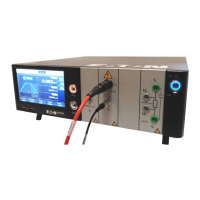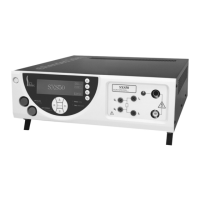User manual SEFELEC 5x Series 192 v1.06
19.5.1.2. DIELECTRIC STRENGTH TESTS WITH DC VOLTAGE
BENEFITS:
* The power of the HV source can be lower than the one necessary in AC voltage (less
weight and more safety for the operator). The current flows through the specimen only dur-
ing the charging phase.
DISADVANTAGES:
* The charging current can trigger the breakdown detection
* The specimen being charged, it must be discharged through the built-in discharge resistance
(1.5 Mohm).
WARNING: Wait enough for the discharge of the specimen capacitance before disconnection
from the unit (about 8 seconds per uF).
* The specimen is tested in only 1 polarity
* The test voltage must be higher than the one provided with AC test voltage. A common rule is
to use a 1.4 correction factor between the DC and the AC voltages (= square root of 2 = ratio
between the rms value of a sinusoidal wave and its crest value):
Udc = UAC * 1.4
19.5.2. Breakdown detection mode selection
The most common and simple leakage current control mode is the threshold current control
mode or IMAX mode. This mode allows setting a maximum limit of current flowing in the speci-
men under test above which the unit detects a breakdown and stops the test by cutting off the
HV generation and memorizing the voltage value on the LCD screen. As described, the HV
source has to supply the leakage current as well as the reactive current coming from its capaci-
tance. Therefore this requires to adjust the breakdown threshold regarding the reactive current
of each specimen, and to follow the procedure:
* Make a test on a good specimen
* Collect the total current flowing
* Adjust the current threshold to a value greater than the total current.
The XS range units offer the above described detection mode, combined with the ∆-I detection
mode (called sometimes ARC detection mode). The ∆-I mode allows to release from the reactive
current flowing in the capacitive specimens.
To detect a breakdown, the ∆-I mode (ARC detection) monitors only the fast-current variations
(t > 10 uS and amplitude > 1 mA). This does not require any adjustment regarding the specimen
capacitance. However this mode cannot detect a dielectric strength default in case of a speci-
men in short-circuit since the high voltage application. That is why the MG range units allow to
combine the IMAX and the ∆-I modes in order to make reliable and without adjustment of dielec-
tric strength tests. The IMAX value is set to a value close to the unit short-circuit current under
the test voltage.
The MG range units allow to inhibit the detection systems (OFF mode) in order to locate visually
where is the dielectric strength fault. WARNING: this mode does not cut off the high voltage and

